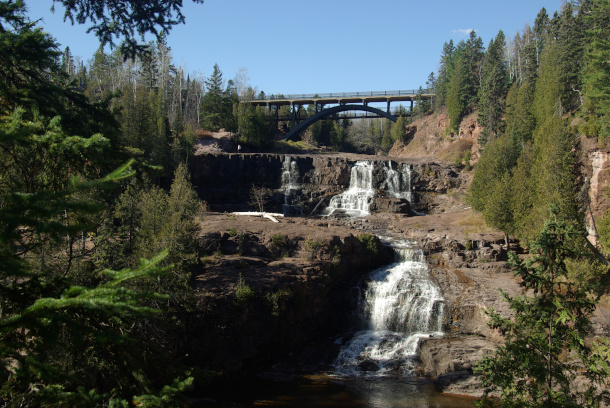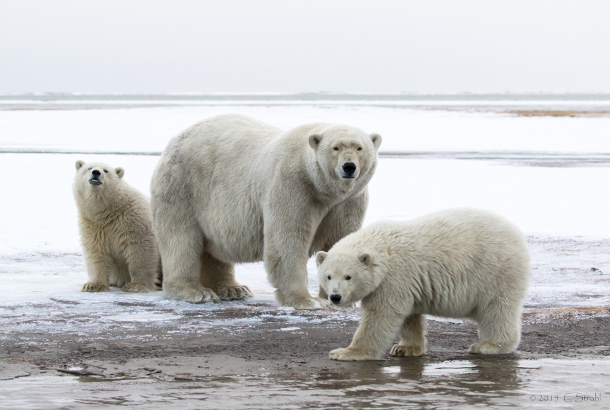Beyond the Headlines
Air Date: Week of October 13, 2023

The northern shore of Lake Superior may be getting too warm for brook trout. (Photo: aaronHwarren, Flickr, CC BY-ND 2.0)
This week, Living on Earth Contributor Peter Dykstra joins Host Paloma Beltran with a couple of warnings from scientists about how the warming planet is affecting species, from brook trout that may get wiped out from streams in the Great Lakes region to mother polar bears who can’t make enough milk because of shrinking Arctic sea ice. In history, they look back to 1988, when three gray whales stuck in the ice captured the world’s attention.
Transcript
BELTRAN: It's just about that time for a look beyond the headlines with our Living on Earth contributor Peter Dykstra. He's joining us now from Atlanta, Georgia. Hey there, Peter, how are you?
DYKSTRA: I'm doing well. Paloma. And I hope you're doing well, too. Here's the story about a species that may not be doing well a prized species for sport fishermen in the uppermost part of the U.S. side of the Great Lakes, as the Great Lakes warm, some of the feeder streams along the Minnesota coastline may be getting too warm for brook trout to survive.
BELTRAN: And from what I understand the Great Lakes have over 150 native fishes, and it's huge for sport fishing. What are natural resource managers going to do about this?
DYKSTRA: Well, natural resources managers alone can't do a whole lot about water getting warmer. But by mid century, the researchers say about a third of the streams in the area studied, the way far North Lake Superior shoreline and Minnesota, will be too warm to host the brook trout.
BELTRAN: Just another unfortunate impact of the climate crisis. Hmm. What else do you have for us, Peter?
DYKSTRA: Something else that's also not good news and something from another cold region. Polar bears might be further affected by climate change. We already know that declining ice is a problem. But that declining ice drives mother polar bears onto land. And when those polar bears nurse where no polar bear food is available on land, there's a problem with raising young polar bears. It's a study published in the Marine Ecology Progress series saying that lactation is quote, "negatively affected by increased time spent on land when the sea ice melts", which we all know is happening very quickly in the Arctic.

A mother polar bear stands with cubs on Barter Island off the north slope of Alaska. (Photo: Cheryl Strahl, Flickr, CC BY-NC 2.0)
BELTRAN: Well, I've seen images of struggling mother polar bears, and they're just heartbreaking
DYKSTRA: It is. And it was thought that that was simply due to a lack of food. This is some scientific evidence that that lack of food for nursing polar bear mothers is essentially doubling the impact on the polar bear species.
BELTRAN: And is there warmer news in the history section?
DYKSTRA: I'm afraid not just a story from Alaska to go along with our stories from Minnesota and Canada. On October 13th 1988, there was a cameraman for the North Slope borough. That's where the town of Barrow is — the center for the oil industry. North Slope borough got so much money from the oil industry that they were able to build a state of the art satellite uplink, and outfit cameraman. Bear in mind this is 1988. There are places a lot bigger that didn't have such equipment. The cameraman was offshore in a snowmobile when he spotted three gray whales stuck in the ice, breathing through a small lead — a small hole in the ice —apparently stuck and potentially dying. When that ice closed up. There was a frenzy to save these three whales. Those pictures ignited this global rescue effort that included the Soviet Union in its last years sending a nuclear powered icebreaker. Two of the three whales are known to have survived. The third one is suspected to have died. And in the end, what came out of it was a major motion picture in 2012 called the Big Miracle, starring Drew Barrymore as Cindy Lowry, one of the heroines in the movie version. It's a great story. Not so great a movie, but there's a catch to all of this.
BELTRAN: What's the catch?
DYKSTRA: At least 100 gray whales, it's believed, die this way every year. These three gray whales happen to get stuck in the ice in front of a video camera and a video uplink for the whole world to see.
BELTRAN: Peter Dykstra is living on Earth contributor. Thank you so much. And we will talk to you again real soon.
DYKSTRA: Paloma, thank you, and we'll talk to you soon.
BELTRAN: And there's more on the stories on the Living on Earth website. That's loe.org.
Links
Bridge Michigan | “In Warming Great Lakes, Climate Triage Means Some Cold Waters Won’t Be Saved”
Living on Earth wants to hear from you!
Living on Earth
62 Calef Highway, Suite 212
Lee, NH 03861
Telephone: 617-287-4121
E-mail: comments@loe.org
Newsletter [Click here]
Donate to Living on Earth!
Living on Earth is an independent media program and relies entirely on contributions from listeners and institutions supporting public service. Please donate now to preserve an independent environmental voice.
NewsletterLiving on Earth offers a weekly delivery of the show's rundown to your mailbox. Sign up for our newsletter today!
 Sailors For The Sea: Be the change you want to sea.
Sailors For The Sea: Be the change you want to sea.
 The Grantham Foundation for the Protection of the Environment: Committed to protecting and improving the health of the global environment.
The Grantham Foundation for the Protection of the Environment: Committed to protecting and improving the health of the global environment.
 Contribute to Living on Earth and receive, as our gift to you, an archival print of one of Mark Seth Lender's extraordinary wildlife photographs. Follow the link to see Mark's current collection of photographs.
Contribute to Living on Earth and receive, as our gift to you, an archival print of one of Mark Seth Lender's extraordinary wildlife photographs. Follow the link to see Mark's current collection of photographs.
 Buy a signed copy of Mark Seth Lender's book Smeagull the Seagull & support Living on Earth
Buy a signed copy of Mark Seth Lender's book Smeagull the Seagull & support Living on Earth

